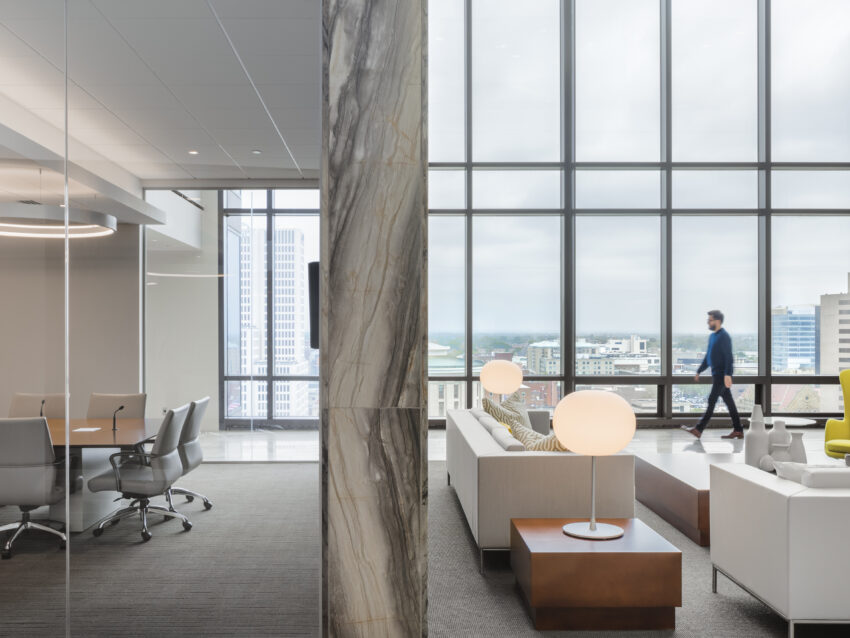The Future of Office Design Includes Flexibility and Efficiency
This article is originally from New York Law Journal, written by Megan Spinos.
The future is now at law offices, as the coronavirus pandemic drastically accelerates two decades of workplace evolution and spurs attorneys to use their space more strategically. While tech firms are widely known for market-leading office advancements, law firms are swiftly adapting.
Law firms are increasing their use of artificial intelligence and other high-tech tools, reallocating space for common areas and amenities, assigning fewer desks, sharing more workstations and making their remaining space more appealing and aesthetically pleasing.
Those are among the findings in new research conducted by Vocon, a national architecture, design and workplace strategy firm with offices in New York City and Cleveland. Vocon’s study is based on a survey of more than 300 law associates, consultations with clients nationally and a synthesis of recent legal sector-related real estate research.
Nearly all of the legal professionals Vocon polled (89%) would prefer to work remotely at least some of the week. Among them, 40% said they would like to work remotely at least three or four days per week, 31% want to work remotely one or two days and 17% would like to switch entirely to a remote option.
More schedule flexibility will likely remain the norm, with 57% of law firm employees expressing a willingness to sacrifice assigned seating for greater flexibility, the survey found. Law firms are spending more on technology to facilitate remote work and to achieve operational efficiencies, with support staff being deployed more judiciously toward areas like billing and collections, according to a 2021 Citibank legal sector analysis.
Critically, real estate—the second highest expense for firms after payroll over the last 20 years—will be used more strategically. For years, the legal field has been gradually moving toward single-size offices, improving and tweaking staff-to-attorney ratios, outsourcing support services and finding efficiencies through new technology tools.
At full capacity in 2019, before the pandemic, law firms averaged 675 square feet per attorney, according to a recent Cushman & Wakefield study. Now, law firms are striving to reach an average target density of 515 square feet per attorney, with nearly two-thirds saying they plan on using 400- to 600-square-foot spaces for each attorney, the same study found.
Attorneys are already reallocating space. This year, 41% of law firms told Cushman & Wakefield they’re using less than 600 square feet for each attorney, up from 27% in 2020. But a third of law firms are still using more than 700 square feet per attorney, meaning many law offices will likely soon invest in major real estate repositioning.
Square footage dedicated to office space for individual attorneys is being repurposed for common, multi-use areas and tech-enabled meeting rooms, attorneys told Vocon. Hoteling and hot desk models—in which workers reserve unassigned private offices and desks for short-term use—are significantly reducing staff-to-space ratios and occupancy levels.
Those legal sector findings are similar to the conclusions in a broader Vocon survey on the future of the American office. Last spring, 103 corporate leaders, who employ nearly 1 million workers at 72 companies nationally, including law firms, participated in that survey.
A total of 33% of Vocon’s spring survey participants reported plans to implement room reservation systems, while 28% are using hoteling or hot desk models. Dropping individual attorneys’ office sizes to 515 square feet by 2026 might sound ambitious.
But law offices typically have a 0.8 to 1 ratio of support staff to attorneys, according to an earlier Citibank analysis from 2018. So, apportioning 515 square feet per attorney would still equate to an average of 275 square feet for each of a firm’s employees—more than two-and-half times the 193 square feet allocated to the average U.S. office worker before the pandemic.
In other words, law offices remain vital, and they’re not disappearing. They’re just being used differently. Physical spaces are essential to help attorneys feel connected and grounded. The lawyers recently polled by Vocon expressed remote work fatigue and longed to return to offices, pandemic permitting.
Remote work can make the mentoring of associates and overall communication more challenging and reduce serendipitous encounters, incidental learning and collaboration. Vocon’s legal survey participants said remote work made them most miss “social interaction” (68%), “connection to company culture” (58%) and “impromptu collaboration” (48%).
Attorneys are freeing up space in law offices for team-building activities, increasing amenities and retrofitting buildings for safer and more flexible use, while preserving bigger offices for senior members. The law offices that remain also will be more visually appealing, with décor, a more connected planning approach, high-tech Zoom rooms and fitness areas, cafés and outdoor work spaces to entice employees to return.
Law firms have faced unprecedented challenges due to COVID-19. But the legal industry is generally more resilient than most economic sectors, given the necessity of its services. Attorneys will continue to view the pandemic as an opportunity to accelerate the reinvigoration of their practices with new technologies and workplace designs that increase flexibility and optionality, while preserving employee privacy and fostering a sense of community.
Megan Spinos is a principal and strategy director at Vocon, a national design firm focused on creating people-driven work environments, with headquarters in Cleveland and offices in New York.
